
Registered Heritage Body HM/CB/28-02-2020/03
NPO 272-966
Protecting Napier’s cultural and natural heritage
Preparatory work for a Napier Heritage Conservation Plan commenced in 2021. This will include a heritage survey of all buildings in the Central Heritage Precinct of Napier, as well as buildings older than 60 years in the Napier municipal area. Additionally, a conservation plan will be developed for the Klippedrift river corridor, Napier commonages, and Renosterveld conservation areas.
This plan is a work in progress. There is a heritage inventory report available below. The Cape Agulhas Municipality is currently finalising these plans.
Napier was chosen in 2024 for a pilot study that will result in a Heritage Plan and Strategy for the broader Cape Agulhas Municipality. Heritage consultants compiled the first Napier Heritage Inventory, which was submitted to Heritage Western Cape in 2024 and approved by HWC early in 2025. The inventory is due to be gazetted later in 2025 after the appeals and public participation process is complete. The Heritage Inventory will then afford all the included properties heritage protection according to their grading level.
The CAM Heritage Plan and Strategy is expected to be approved late 2025, early 2026
All relevant documents can be found on the Cape Agulhas Municipality website. The NHCB takes no responsibility for any outdated or incorrect information.
Napier is surrounded by a network of agricultural commonages as well as small conservation areas containing Overberg Renosterveld, including the Cameron MacMaster Renosterveld Reserve, Napier Ferricrete Renosterveld Reserve and the Skurwekop conservation area, which forms part of the Napier West Commonage.
The Overberg Renosterveld is one of the world’s most threatened vegetation types and is recognised as critically endangered. Less than 5% of its former extent remains due to extensive encroachment on this vegetation for agriculture. The remainder is under constant threat of illegal ploughing, overgrazing, as well as insecticide drift and runoff from agricultural chemicals.
The NHCB is combining forces with the Southern Overberg Botanical Society, the Overberg Renosterveld Conservation Trust and the Cape Agulhas Municipality to conserve these pieces of natural heritage, while private land owners established the Napier Mountain Conservancy on Soetmuisberg back in 2008. Three of the properties making up the conservancy have been assessed by CapeNature as being of such high conservation value that they qualify for Contract Nature Reserve status. This project is in various stages of implementation by individual landowners.
The agricultural commonage surrounding Napier has been part of community life for nearly two centuries, forming an important food security net for the residents of Napier. Known in previous decades for the excellent sweet potatoes and strawberries it produced, most of the commonages are used today for grain production as well as cattle and sheep grazing.
The area surrounding Napier is one of the world’s most species-diverse Mediterranean-type shrublands. And the remaining patches of Renosterveld have enormous ecological and eco-tourism significance.
The Vlermuiskelderkloof Stream that rises below the Vierfontein Dam and becomes the Klippedrift River is Napier’s main water source, which is supplemented by additionalgroundwaterr. It is of great environmental, socio-economic and heritage importance to the village.
The intention is to restore the quality of the water in the stream by removing all the invasive vegetation and opening up the banks so they can be used as a recreational space. The village’s historic leechwater system will also be restored where possible.

The Napier area conserves two natural areas of high conservation value – tracts of unspoilt Renosterveld and the Soetmuisberg (Napier Mountain). The soils of the Renosterveld are fertile, which has led to their transformation to support the growing of wheat, Canola, and barley. In the winter months, these crops turn the softly rolling hills into a quilt of bright yellow and green. The exception is the three Overberg Renosterveld patches near the village, which remain dull throughout the year, even in spring.
If they are so dreary, why should these patches be conserved?

Just take a walk through these plots anytime and often from July to November, where you will be captivated by the richness of the flora, particularly the diversity of the bulbs. This led the late Cameron McMaster, respected worldwide for his knowledge of our flora, to believe that the Southern Overberg Renosterveld is indeed the bulb capital of the world – Ixias, Gladiolus, Babiana and many more plant families and species survive in these areas and nowhere else on the planet. One can only guess the number of species that have gone extinct where these wild places have been put to the plough to grow crops.
The mountain, on the other hand, is covered in the more famous fynbos despite it growing on very poor soils. Its flora is so diverse in its species that it is regarded as having more species in a comparable area than can be found anywhere else on earth. Up until now, its biggest threat has been a variety of invasive alien species, such as pine from North Africa and a range of species, mainly from Australia, that feel very confident about displacing all our flora. Indeed, the conservancy protects one of the most threatened plant species on earth, an Erica species, where fewer than 50 plants are known to be left in the world.
We can be very grateful that the Overberg Renosterveld Conservation Trust and the Napier Mountain Conservancy play such an active role in fighting these invasives. Although the fight seems lost, they keep trying so that there are large tracts that can still be seen in a largely pristine state.
The Southern Overberg Botanical Society is also active in the area, where there are several volunteer alien clearing groups clearing invaded areas and restoring these to near-pristine condition.
Much as Napier is aware of its rich cultural and architectural heritage, it is also very active in preserving its great natural heritage for residents and tourists, and also for its wildlife and wild places, for generations to come.
If you have any historical documents, photos or stories of the residents and the town throughout its history, please don’t hesitate to contact us via email using the button below.
Thank you to all our sponsors.